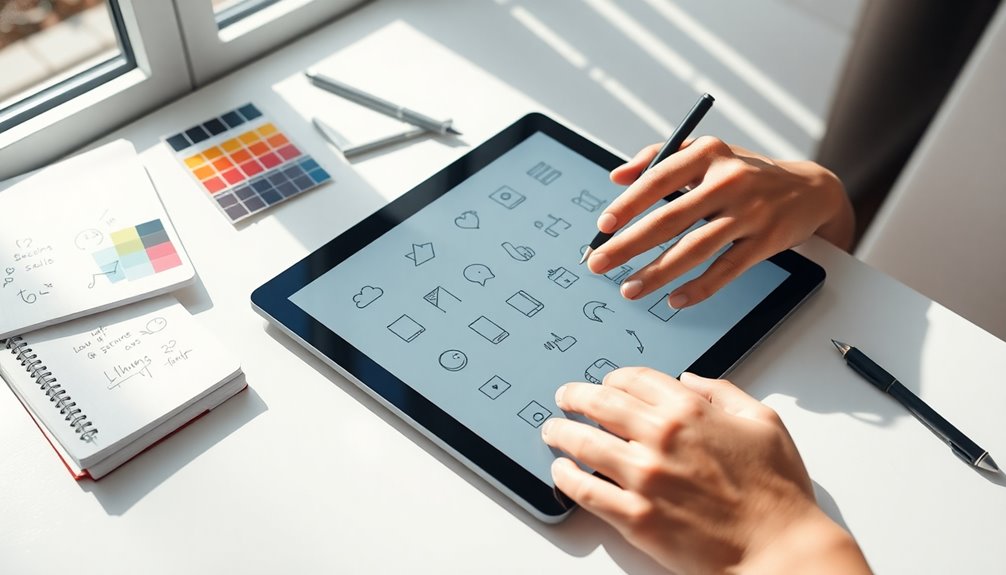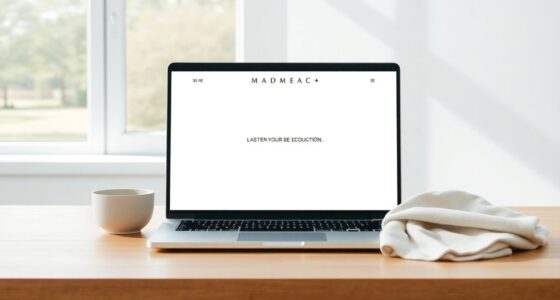Creating custom minimalist icons for your brand is essential for establishing a strong visual identity and enhancing user engagement. Focus on simplicity and consistency to guarantee recognizability across platforms. Choosing the right color palette can evoke emotions and align with your brand. Utilize geometric shapes for clarity and leverage design tools like Canva or Flaticon Creator for ease. By implementing best practices, you can craft icons that effectively communicate your message. Discover more tips and strategies to elevate your icon design further.
Key Takeaways
- Start by defining your brand identity to ensure your icons reflect your values and visual style.
- Select a limited color palette that aligns with your brand and enhances recognizability.
- Focus on simplicity by using essential shapes and negative space to avoid visual clutter.
- Utilize design tools like Canva or Flaticon to create and customize your icons easily.
- Ensure icons are versatile with transparent backgrounds and optimized formats like SVG for better web integration.
Understanding the Importance of Minimalist Icons
Minimalist icons are essential for effective branding in today's digital landscape. By utilizing simplicity and clarity in icon design, you create visuals that users can easily recognize and remember.
A reduced color palette enhances brand consistency, ensuring your visual identity stands out. These icons greatly improve user experience by providing straightforward cues that guide navigation and communicate your brand message effectively.
The clean lines and geometric shapes typical in minimalist icons contribute to a modern aesthetic that resonates with contemporary graphic design sensibilities. Incorporating these icons not only elevates the professional appearance of your website or application but also fosters trust and engagement with your users, making them an invaluable asset for your brand. Additionally, the concept of emotional intelligence plays a significant role in understanding how users interact with visual elements, enhancing overall user satisfaction.
Key Elements of Effective Icon Design
Effective icon design revolves around a few key elements that guarantee clarity and functionality. By focusing on these aspects, you can create unique icons that resonate with your audience.
Effective icon design hinges on simplicity, consistency, and usability, ensuring clarity and functionality that connects with your audience.
- Simplicity: Use minimal shapes and colors to enhance recognizability across various platforms and sizes.
- Consistency: Align your icons with your brand's visual identity, ensuring a cohesive color palette that reflects your overall branding strategy.
- Usability: Design with users in mind, making icons intuitive and easy to understand for better navigation.
Additionally, utilizing a transparent background is essential for versatility, allowing your icons to fit seamlessly into different contexts. Moreover, focusing on content quality can enhance your brand's overall perception and user engagement.
Choosing the Right Color Palette
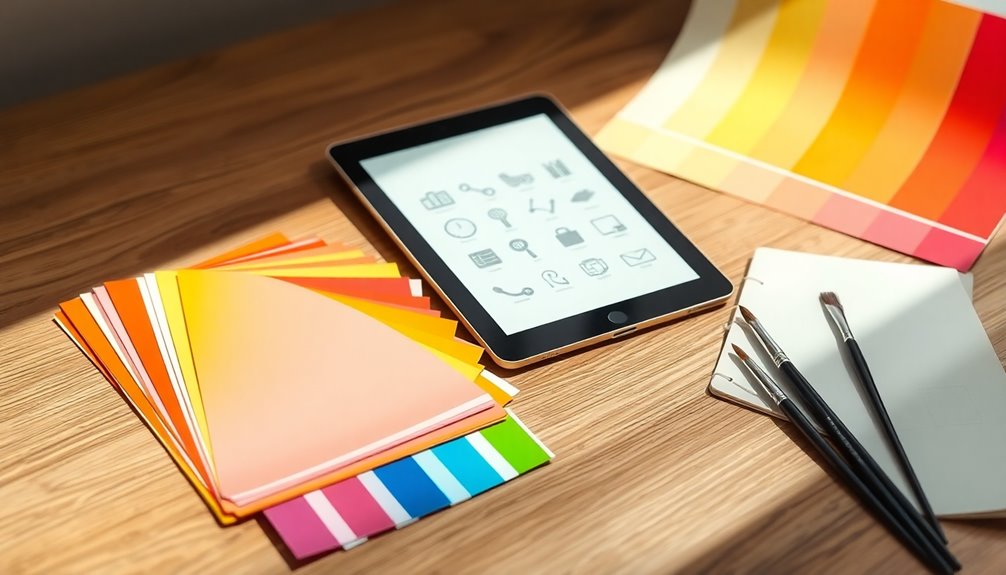
Choosing the right color palette is key to aligning your minimalist icons with your brand identity.
Remember, colors evoke emotions; a well-thought-out palette not only enhances your design but also reinforces brand consistency. Additionally, astrological compatibility can influence how your color choices are perceived in relation to your target audience's preferences.
Color Psychology Impact
While developing your brand's identity, understanding color psychology can greatly impact how your audience perceives your brand. Selecting a thoughtful color scheme not only enhances visual recognition but also influences consumer behavior.
Here are three emotions colors can evoke:
- Trust: Blue instills a sense of calm and reliability.
- Excitement: Red generates urgency and enthusiasm.
- Serenity: Green promotes balance and harmony.
A cohesive color scheme for your minimalist icons improves user experience by making navigation intuitive. Additionally, the importance of maintaining personal privacy in relationships highlights how thoughtful branding can create a sense of intimacy and connection with consumers.
Remember to prioritize accessibility; high contrast between colors and backgrounds guarantees legibility, especially for users with visual impairments.
Testing various combinations and gathering feedback can help you discover which palettes resonate best with your target audience, creating a deeper emotional connection.
Brand Consistency Importance
When you prioritize brand consistency, the right color palette becomes essential for conveying your brand's identity. Using a limited color scheme, typically one or two colors, not only enhances visual clarity but also reinforces the minimalist design principles of your custom icons.
This approach promotes visual harmony, aligning your icon designs with your overall brand color scheme. Research indicates that consistent use of color can boost brand awareness by up to 80%, making it vital for effective custom icon design.
Additionally, choosing colors that resonate with your brand's values and target audience fosters emotional connections, leading to higher engagement rates. Incorporating brand consistency importance into your design strategy can significantly enhance your brand's recognition.
Ultimately, the right color palette solidifies your brand's presence across various platforms, ensuring your message is both clear and memorable.
Exploring Geometric Forms
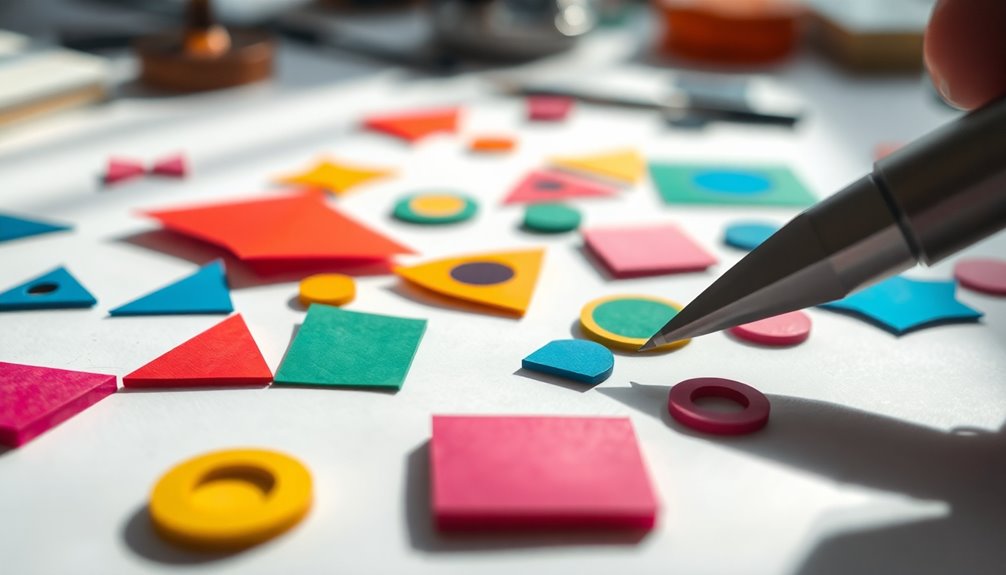
Geometric forms serve as the backbone of minimalist icon design, providing clean lines and recognizable shapes that enhance visual clarity. By utilizing basic shapes, you create memorable and effective icons that resonate with your audience.
Consider these emotional connections:
- Circles evoke unity and wholeness, perfect for community-focused brands.
- Squares convey stability and reliability, ideal for tech or finance.
- Triangles suggest innovation and forward-thinking, great for creative industries.
Customizing geometric icons by altering colors and sizes guarantees they align with your brand identity while maintaining a minimalist essence. Additionally, the growing demand for skilled analysts highlights how effective iconography can enhance user engagement and drive business strategies.
You can also combine or layer these geometric forms to create versatile icons that serve various functions across digital platforms, making your brand more impactful and recognizable.
Simplifying Shapes for Clarity
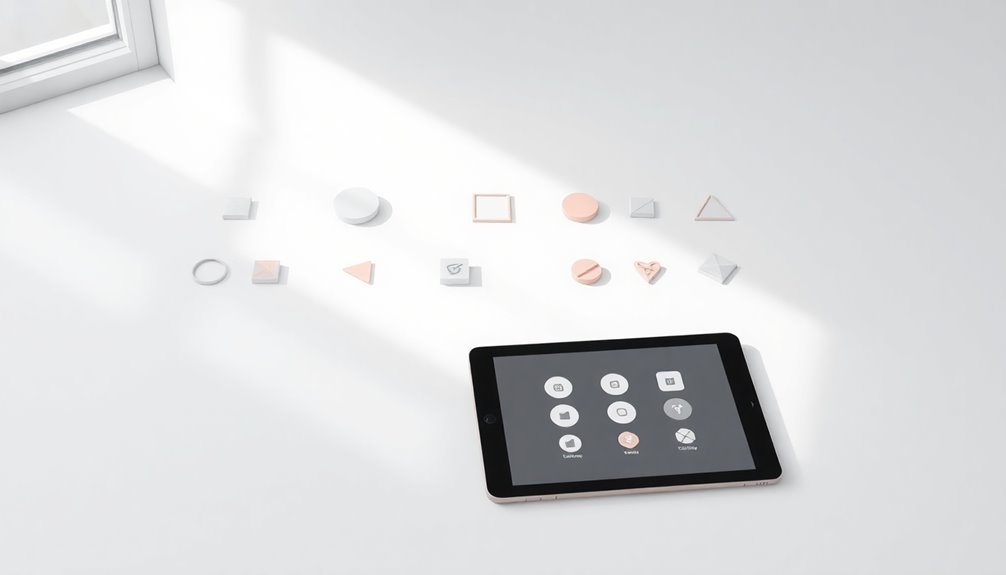
When creating minimalist icons, you should focus on essential shape selection to enhance clarity and recognition. Sticking to a consistent color palette can further streamline your designs, allowing the shapes to take center stage. Additionally, employing AI-driven analysis can help refine your icon designs by identifying which shapes resonate most with your target audience.
Essential Shape Selection
To create effective custom minimalist icons, it's crucial to focus on basic shapes like circles, squares, and triangles. Simplifying complex objects into these fundamental forms guarantees clarity and quick recognition.
Here are three key considerations for your shape selection:
- Simplicity: Use a limited number of shapes to avoid visual clutter and enhance the design.
- Negative Space: Embrace empty spaces within your icons; this can greatly improve shape recognition and create balance.
- Brand Alignment: Confirm your chosen shapes resonate with your brand's identity, reflecting its personality while keeping the design clean. Incorporating basic shapes can lead to more effective communication of your brand message.
Color Palette Consistency
A consistent color palette is essential for creating minimalist icons that resonate with your audience. By maintaining color palette consistency, you enhance brand recognition and establish a cohesive visual identity across all marketing materials.
When customizing icons, select one or two colors from your brand's established color scheme. This approach simplifies shapes in icon design, allowing clearer communication of ideas. A clean design avoids visual clutter, making your icons easily interpretable at a glance.
Additionally, consistent color usage supports visual hierarchy, guiding users' attention to key elements and improving their overall experience. Ultimately, aligning your color choices with your brand identity promotes trust among your audience, making your minimalist icons even more impactful. Furthermore, high-quality content not only elevates your brand's visual identity but also boosts your overall credibility and trustworthiness in the market.
Ensuring Versatility Across Mediums
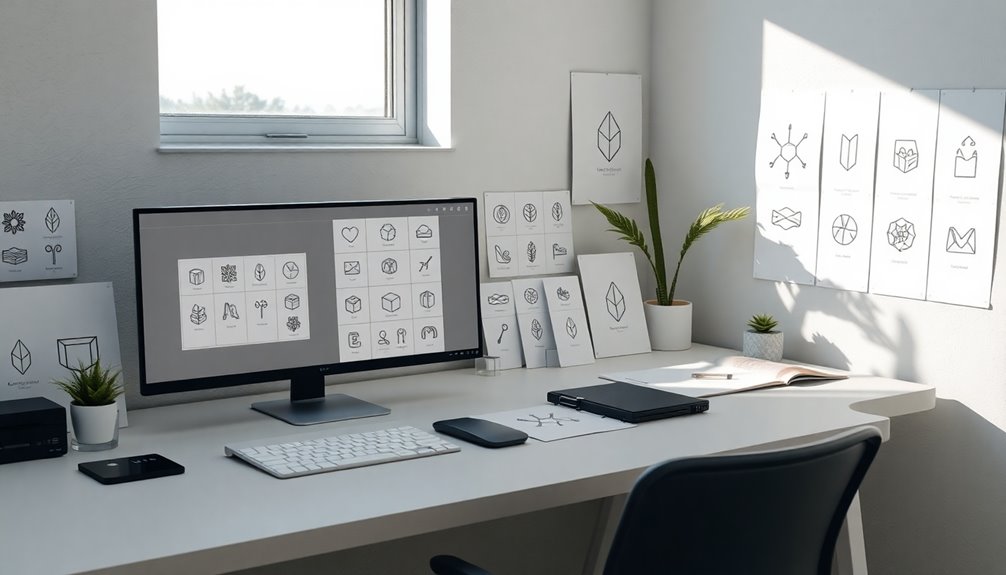
Creating custom minimalist icons that work seamlessly across various mediums is essential for effective brand representation.
To guarantee versatility, consider these key aspects:
- Transparent Backgrounds: This allows your icons to integrate smoothly into different graphics and layouts.
- Consistent Dimensions: Use a minimum size of 320 x 320 pixels to maintain sharpness and professionalism across platforms.
- Web-Friendly Formats: Opt for SVG or PNG format when you create custom icons, as they provide compatibility across websites and applications.
Make sure your icons are responsive and adaptable, using relative units for sizing. This way, they'll maintain clarity and functionality on various devices. Additionally, integrating energy-saving features into your designs can further enhance their appeal while promoting sustainability.
With a free online icon maker, you can easily achieve these design elements while enhancing your brand recognition.
Tools for Creating Custom Icons
While designing custom icons may seem intimidating, numerous tools can simplify the process and make it accessible to everyone. Websites like Flaticon.com offer a vast selection of free icons, allowing you to find the perfect base for your design.
You can create unique custom icons in under a minute using user-friendly platforms like Canva or Flaticon Creator, which feature intuitive design editors and drag-and-drop functionality. HubSpot's icon generator is another great option, enabling you to create personalized icons without any design skills.
Simply input your business ideas and customize templates to match your brand's personality. Be sure to download your icons in web-friendly formats like SVG or PNG for versatility across various projects.
Best Practices for Icon Implementation
Once you've crafted your custom minimalist icons, it's time to think about how to implement them effectively. Here are some best practices to keep in mind:
- Use transparent backgrounds: This versatility guarantees your icons blend seamlessly with any design, enhancing your brand identity.
- Choose SVG icons: They're web-friendly and optimize loading times, making your site faster and more user-friendly.
- Adopt responsive design: Use relative units for sizing, allowing your icons to scale nicely across devices and screen sizes.
Don't forget to align your icon colors with your overall palette for visual cohesion.
Also, provide alternative text for accessibility, making sure everyone can appreciate your thoughtful designs.
With these tips, your icons will shine!
Showcasing Your Icons in Branding
Showcasing your custom minimalist icons is essential for establishing a strong brand identity. By creating a cohesive visual language, these unique icons resonate with your target audience.
Use a consistent color palette across your icons to reinforce brand recognition and guarantee visual harmony in all your marketing materials. Display your icons in versatile formats, like SVG or PNG, maintaining design integrity across platforms.
Incorporating transparent backgrounds increases flexibility, allowing seamless integration with various layouts. Don't forget to utilize icon packs; they streamline your design process and guarantee all your icons align with your brand's aesthetic.
Whether you're using a logo maker or looking for a free icon, these strategies will enhance your brand's overall appeal.
Frequently Asked Questions
How to Create a Brand Icon?
To create a brand icon, start by brainstorming ideas that represent your brand's identity.
Then, explore platforms like Flaticon.com for inspiration or icons to customize. Use online tools like Canva to modify the design easily.
Keep it minimalist by choosing one or two colors that reflect your brand.
Once you're happy with the design, download it in web-friendly formats like SVG or PNG for seamless integration across your marketing materials.
What Is the Best Free Icon Maker?
Did you know that 70% of consumers recognize brands by their logos alone?
If you're looking for the best free icon maker, consider Flaticon.com. It offers a vast selection of icons and easy customization to fit your needs.
HubSpot's icon generator is another great choice, as it's user-friendly and doesn't require design skills.
Both platforms provide web-friendly formats, ensuring your icons are versatile for any digital project.
How to Make Custom Icons in Windows 11?
To make custom icons in Windows 11, start by using built-in tools like Paint or download software like GIMP or Inkscape.
Design your icon, ensuring it's 256×256 pixels for clarity. Save it as a PNG or ICO file.
If you have a PNG, you can use online converters to turn it into an ICO file.
Finally, right-click your shortcut, choose "Properties," then "Change Icon" to set your new design.
How Do I Create an Icon From an Image?
To create an icon from an image, start by choosing your image and using an icon maker tool like Canva.
Make sure the image has a transparent background for versatility. You can customize the colors and shapes to fit your style.
Adjust the size and proportions using the editing tools, aiming for web-friendly formats like SVG or PNG.
Finally, download your finished icon, typically at dimensions of 320 x 320 pixels for best results.
Conclusion
In crafting your brand's identity, custom minimalist icons serve as the subtle brushstrokes on a canvas, transforming a chaotic image into a compelling masterpiece. Just like a well-composed symphony relies on each note for harmony, your icons should resonate with simplicity and purpose. Remember, 94% of first impressions are design-related, so take the time to create icons that not only represent your brand but also leave a lasting impact. Embrace this art, and let your brand shine.
